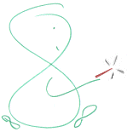
a commentary on the spiritual life
The I Thought
I am me, and you aren’t
Before or after reading this, please consider reading this.
In the beginning, we create, and then throughout our lives we sustain, our sense of self by perceiving ourselves as separate and apart from others. That is, we create the appearance of a separate self, which each of us calls “me” and “my life,” by establishing artificial personal boundaries beyond which everything else is perceived as “not me” or “others.” Perhaps the most obvious of these boundaries is the body’s skin, the physical point of demarcation between “me” and everything else. This process of personal identification, which we might call the human condition, is a product of the “I-Thought,” sometimes known as the ego. The I-Thought defines ourselves for ourselves by the statement, ”I am this and not that.” The first cousin of the I-Thought is the my-thought, which informs us “This is mine, not yours.”
We are introduced to the I-Thought very early in life by adoring parents, who, gushing over us with affection, insist, “I am mommy, you are my baby. I am me, you are you.” “I am your father, you are my son, I am me. You are not me, you are you.” Of course, they mean well, for they love us dearly. But, all the same, they (and all the other authority figures that populate our youth) teach us wrongly, and as a result of their misdirection, we grow up convinced we are some body, the offspring of two other bodies. To coin a phrase, “I am me, and you aren’t.”
Once established, the I-Thought becomes the first thought we have on awakening in the morning, and the last thought before sleep. Throughout our waking day, as well as in the dream state, it attaches itself to every other thought, perhaps even gives birth to every other thought, so that an inescapable, underlining and determining aspect of everything else we may think, dream, anticipate, dread, or imagine is always, “I am this and not that.” Thus, “I am me and not her,” “I am Buddhist and not Christian,” “I am black and not white,” “I am this body and not that piece of paper,” “I am this person and not that concept,” “I am happy and not sad,” “I am Bolivian and not Japanese,” “I am male and not female,” “I am alive and not dead,” and so on. Everything else we think about everything else is shaped, conditioned, limited, colored, energized, by the I-Thought. Every other thought is processed through that filter.
Thus, it is the I-Thought that enables us to consider others as others, to perceive them, to think about them, to dream of them, to judge them, whether they be people, objects, concepts or whatever. The I-Thought informs us they are not us, and therefore we consider them accordingly. Absent the I-Thought, we would see everything as ourselves — as perhaps new-born infants do in the first hours of birth, before their earthly authorities have had the opportunity to “correct” them.
We have been harboring and nurturing the I-Thought so effectively and so faithfully for so many years, we are now hopelessly addicted to it; so much so that it has become completely automatic and unconscious, like breathing. Indeed, our first reaction on learning of it, as spiritual seekers, is often surprise or disbelief, followed later, at the suggestion of erasing it, by fear. “Who will I be, if not me?” or, “Without others, I’d be alone.” Or, “If I give up my stuff, I’ll have nothing.” What we do not yet realize, of course, is that the sense of fear and poverty, and all their derivatives, including loneliness, are a product of the I-Thought, and will go with it.
Ultimately, elimination
of the I-Thought is the heart and soul of the spiritual process, and
so, sooner or later, in one way or another, each of us must address
it. Happily, with aspiration, determination, earnestness,
and![]() (seemingly endless)
practice, seasoned with generous doses of discipline,
silence, and prayer, the I-Thought can be uncovered and isolated, and,
then, by the Grace of God, undone.
(seemingly endless)
practice, seasoned with generous doses of discipline,
silence, and prayer, the I-Thought can be uncovered and isolated, and,
then, by the Grace of God, undone.
In the meantime, try this practice. While
sitting silently, imagine the I-Thought subsiding from  the
brain, carrying with it all the labels and distinctions that begin with
the words “I” and “my,” descending slowly earthward like a pricked balloon,
gently drifting past your eyes, nose, and mouth, along the length of
your neck, into the chest, finally settling at your heart, there to
be absorbed. Now, when it immediately comes back to life, which it surely
will, and bounces back into the brain, simply repeat the practice, patiently
and without frustration. Or try this: Throughout the day, whenever you
encounter another, be it a person or a thing or an idea or an experience
or even a change in the weather, observe it deliberately, and then say
to yourself, with affection and conviction, “I am that” or “That I am.”
the
brain, carrying with it all the labels and distinctions that begin with
the words “I” and “my,” descending slowly earthward like a pricked balloon,
gently drifting past your eyes, nose, and mouth, along the length of
your neck, into the chest, finally settling at your heart, there to
be absorbed. Now, when it immediately comes back to life, which it surely
will, and bounces back into the brain, simply repeat the practice, patiently
and without frustration. Or try this: Throughout the day, whenever you
encounter another, be it a person or a thing or an idea or an experience
or even a change in the weather, observe it deliberately, and then say
to yourself, with affection and conviction, “I am that” or “That I am.”
Editor’s Note: For more about the creation of “others,” please consider my book In The Beginning.

Are you looking for me? I am in the
next seat.
My shoulder is against yours.
You will not find me in stupas, not
in Indian shrine rooms
nor in synagogues, nor in cathedrals;
not in masses, nor kirtans, not in
legs winding around your neck,
nor in eating nothing but vegetables.
When you really look for me, you will see me instantly
—
You will find me in the tiniest house of time.
Kabir says: Student, tell me, what is God?
He is the breath inside the breath.
Stupa – Buddhist temple (“hair knot” architectural form to honor the Buddha or to mark a sacred spot.)
Kirtan – Communal chanting, singing, & dancing to honor the Divine.
(Back to Text)
Please read our disclaimer.
For Copyright © & Trademark ™ information,
please click here.
![]()
To get out of another’s frame,
please click here.

